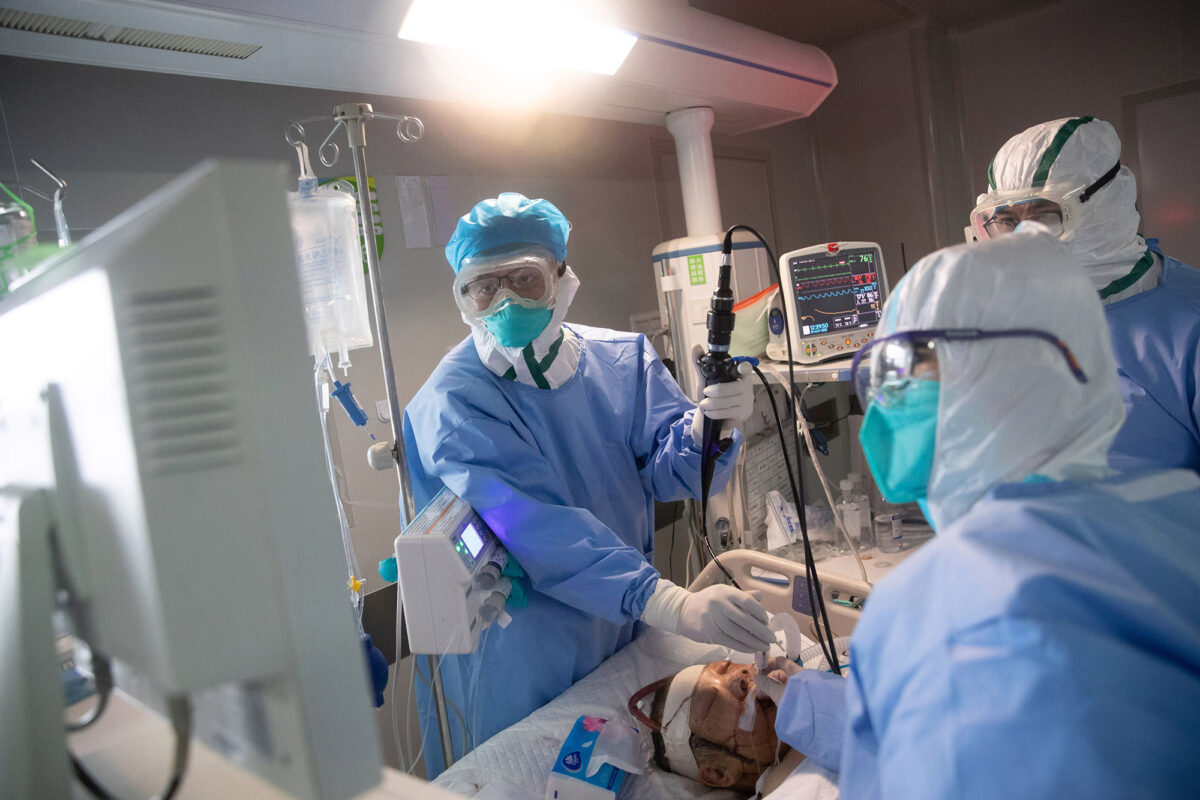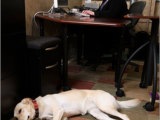By Glynn Wilson –
While a theory of a possible leak from a government science lab in Wuhan, China has dominated the news coverage especially on social media on the origin of the novel coronavirus that led to the global Covid-19 pandemic and how the strain SARS-CoV-2 jumped from animals to humans, and this was seized on by politicians on the political right in the United States to blame China and avoid responsibility themselves for its viral spread in the U.S., a new study that only recently came to light reveals that the lab leak theory is bunk.
A scientifically educated world traveler who has hiked all over China and India early on described the unsanitary sewer situations in those countries in anonymous interviews. What he describes is how in the absence of sanitary sewer systems, yards in China have a pond contaminated by human sewage and RNA. There are fish in the pond, being eaten by the ducks. The ducks are killed and cooked, then their remains are tossed back into the ponds. The chickens and pigs eat the animal parts too, and drink the water.
Then the chickens are cooked and eaten, and their parts are tossed back in, as well as the pigs and all the other animals being sold in the wet markets. It’s not just in the yards. The same thing happens in the jakes of the wet markets. All manner of animal parts get mixed up with human RNA.
Similarly, just this past year, a scientist found hook worm in raw sewage ponds in yards in Alabama’s poor Black Belt. Hook worm had not been seen in the U.S. in more than 50 years.
Is it not only possible, but likely, that unsanitary sewers are where the problem originated and spread to humans? Considering all the different animals that carry coronaviruses sold illegally in the wet markets in the area, and how the animal parts are fed to other animals and thrown into the sewer ponds and outhouses where they are mixed with human RNA, we figured the science would eventually lead to the conclusion that it came from the outhouses in the Wuhan markets.
In an email interview awhile back, I talked about the sanitary sewer situation with Stanley Perlman, Chair in Virology in the departments of Microbiology and Immunology and Pediatrics at the University of Iowa.
“I think that your assessment of sanitation is accurate,” he said. “But I do not think that human RNA combined with any other RNA to result in SARS-CoV-2. There is no human RNA in the virus and RNA recombination does not occur outside of cells,” he said. “So unsanitary sewers could contribute to spread, but not to the origin of the virus.”
But when pressed, after I asked: “What about in regards to how it jumped from animals to humans? Does it really have to be one species? Or could there be more than one killer here, like on the Orient Express?
“Wei Guixian (the first known person to contract Covid-19) did not get it from eating bat soup,” I said. “She reported being sick after breathing in the fumes of the jakes where all these animal parts were mixed together with the human feces. If not one species has the exact strain, it’s a mutation, right?”
“There is likely an intermediary species, but the process is linear,” he insisted (see conclusions in the end).
First Reports
It was reported early on that the first woman presumed to have contracted Covid-19 got it after visiting an outhouse in the Huanan Seafood Wholesale Market in Wuhan, China. But in the reporting since, none of the publications with full time science writers have focused on this. The Wall Street Journal has a report about it early on in a report protected by a paywall.
How It All Started: China’s Early Coronavirus Missteps
“It was on Dec. 10 that Wei Guixian, a seafood merchant in this city’s Hua’nan market, first started to feel sick. Thinking she was getting a cold, she walked to a small local clinic to get some treatment and then went back to work,” the paper reported.
“Eight days later, the 57-year-old was barely conscious in a hospital bed, one of the first suspected cases in a coronavirus epidemic that has paralyzed China and gripped the global economy. The virus has spread around the world and sickened more than 100,000.” (It has since killed about 4.5 million worldwide and 645,068 in the U.S., according to the Worldometer).
For almost three weeks, doctors struggled to connect the dots between Ms. Wei and other early cases, many of them Hua’nan vendors. Patient after patient reported similar symptoms, but many, like her, visited small, poorly resourced clinics and hospitals. Some patients balked at paying for chest scans; others, including Ms. Wei, refused to be transferred to bigger facilities that were better-equipped to identify infectious diseases.
When doctors did finally establish the Hua’nan link in late December, 2019, they quarantined Ms. Wei and others like her and raised the alarm to their superiors. But they were prevented by Chinese authorities from alerting their peers, let alone the public.
She was called “patient zero” by a few other publications citing the Wall Street Journal report.
The 57-year-old woman who sold live shrimp … “was the first person from the Huanan market in Wuhan to test positive for the deadly bug,” some tabloid newspapers reported. I don’t think this was ever reported in The New York Times or The Washington Post or on cable TV news in the U.S.
“I felt a bit tired, but not as tired as previous years,” she told The Paper in China. “Every winter, I always suffer from the flu. So I thought it was the flu.”
She visited a local clinic on Dec. 11 and received an injection, but didn’t feel any better, so she went to the Eleventh Hospital in Wuhan.
“The doctor at the Eleventh Hospital could not figure out what was wrong with me and gave me pills,” Wei told the Chinese outlet — but those didn’t work either.
“By then I felt a lot worse and very uncomfortable,” Wei said. “I did not have the strength or energy.”
On Dec. 16, Wei went to Wuhan Union Hospital — one of the city’s largest hospitals — to get checked out. A doctor there described her illness as “ruthless” and told her several other people from the same market had already come in with similar symptoms.
By the end of the month, she was quarantined when doctors finally established the link between the emerging bug and the seafood market, the Chinese outlet reported.
A Dec. 31 statement from the Wuhan Municipal Health Commission revealed that Wei was among the first 27 patients to test positive for COVID-19, and one of 24 cases with direct links to the seafood market.
Wei, who eventually recovered after treatment, said she thinks she contracted the infection from a toilet in the market she shared with meat sellers and others, according to a paragraph way down near the end of the article in the Journal. The vendors who worked on either side of Wei, along with one of her daughters, a niece and the niece’s husband, also caught the deadly bug, the paper reported.
“A lot fewer people would have died” in the country if the government had acted sooner, Wei said.
Suppressed Study Published
Now many months later, we find out about a scientific study that could have shed considerable light on this early on.
When an international group of scientists organized by the World Health Organization traveled to Wuhan, China early in the pandemic to research the origins of the coronavirus that sparked the global COVID-19 outbreak, one of the places they visited was a wet meat market called Baishazhou. It’s a larger, but less well-known place than the Huanan market in the same city, where many scientists initially reported the connection to the first cases of the novel virus, where it presumably jumped from some wild animal or animals to humans.
The research team was told only frozen foods and ingredients along with kitchenware were sold there. But a recently released study that had previously languished in publishing limbo shows, thanks to data meticulously collected over 30 months, that at least two vendors regularly and illegally sold live wild animals there.
One of the earliest recorded COVID-19 clusters in Wuhan [Dec. 19, 2019] involved a Huanan stall employee who traded goods back and forth between the two markets.
A link between them would be “very intriguing,” Stephen Goldstein, an evolutionary virology research associate at the University of Utah told Bloomberg News in the first media report on this study, which is also protected by a paywall.
It seems likely to Goldstein that some authorities in China and public officials didn’t want the presence of a thriving wildlife trade to become public knowledge, so they covered it up in public statements.
“It seems to me, at a minimum, that local or regional authorities kept that information quiet deliberately. It’s incredible to me that people theorize about one type of cover-up,” he said, referring to the hypothesis that the virus actually leaked from a nearby government-run lab, “but an obvious cover-up is staring them right in the face.”
In the absence of reliable data from China in the early days of the pandemic, the Wuhan lab theory gained steam in the mainstream media and was seized upon by politicians on the political right in the United States to blame China and avoid blame themselves for allowing the spread domestically.
Related: Why Solving the Murder Mystery of the Coronavirus Origin is Politically Important
The new study, published in the journal Scientific Reports by Nature.com, contains “meticulously collected data and photographic evidence supporting scientists’ initial hypothesis — that the outbreak stemmed from infected wild animals…”
So much for the lab leak theory.
According to the report, minks, civets, raccoon dogs, and other mammals known to harbor coronaviruses were sold in plain sight for years in shops across the city, including the now infamous Huanan wet market, to which many of the earliest Covid cases were traced.
Researcher Xiao Xiao’s animal logs included masked palm civets and raccoon dogs — both involved in the 2003 SARS outbreak — and other species susceptible to coronavirus infections, such as bamboo rats, minks and hog badgers. Of the 38 species Xiao documented, 31 were protected species and sold illegally.
Anyone caught violating China’s wild animal conservation law faces fines and up to 15 years of imprisonment. But enforcement was lax, as evidenced by the fact that many of the Wuhan shops displayed their wares openly, “caged, stacked and in poor condition,” Xiao observed in the report.
Xiao estimated that 47,381 wild animals were sold in Wuhan over the survey period.
Collaborating with four more scientists, including three from the University of Oxford, Xiao had submitted their manuscript to a journal for publication in February of 2020 — only to have it rejected.
“Had the study been made public right away, the search for the origins of the virus might have taken a very different course,” according to Bloomberg.
Key Data and Coverup
Disease detectives arriving from Beijing on the first day of 2020 ordered environmental samples to be collected from drains and other surfaces at the market. Some 585 specimens were tested, of which 33 turned out to be positive for SARS-CoV-2. All but two of the positive specimens came from a cavernous and poorly-ventilated section of the market’s western wing, where many shops sold animals.
As other nations began blaming the Chinese Communist Party for the pandemic, the government grew defensive. It may have been embarrassed that its citizens were still eating wild animals bought in wet markets — a well-known path for zoonotic disease transmission that China tried unsuccessfully to outlaw almost 20 years ago.
Geng Shuang, a spokesman for China’s Foreign Ministry, denied “wildlife wet markets” existed in the country.
New Report Suggests a Different Chinese Government Cover-Up on Covid-19 Origins
Conclusion
So now we know all the species sold in the market that could have had strains of the coronavirus, strains which were found on the pipes in the market, and we know that they all became mixed up in the outhouses, where the woman first breathed in the disease that passes in respiratory droplets.
It has also been confirmed in sewer systems all over the world.
So it seems logical and inevitable that the mutation becoming SARS-CoV-2 developed there in that outhouse in Wuhan, and other variants such as the Delta or Dixie variant spreading now are not only being spread in the air but also from sewage.
That’s why it’s so important to not only get the vaccine and continue wearing masks, but also to wash your hands frequently and well and to use an alcohol based hand sanitizer.
___
If you support truth in reporting with no paywall, and fearless writing with no popup ads or sponsored content, consider making a contribution today with GoFundMe or Patreon or PayPal. We just tell it like it is, no sensational clickbait or pretentious BS.














